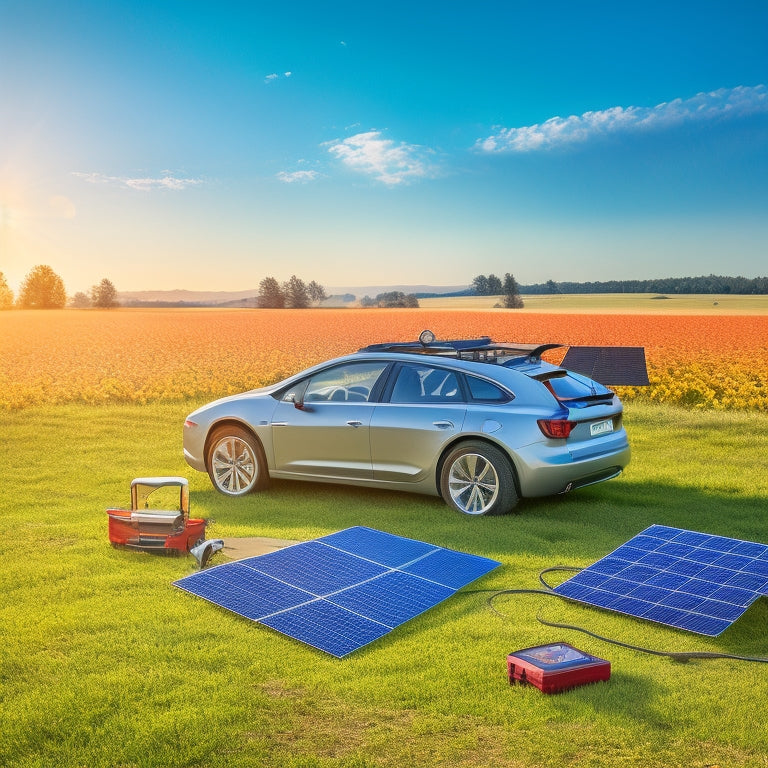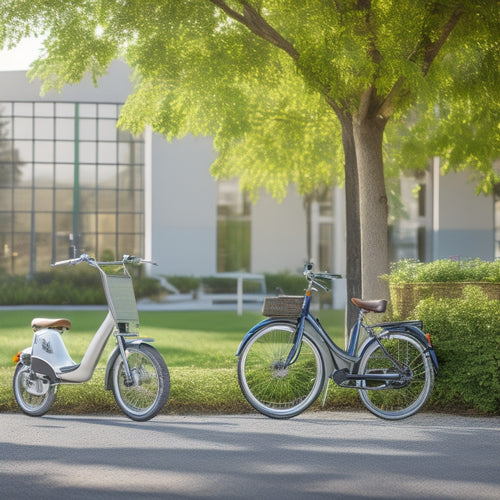
10 Ways to Save on Solar Car Battery Maintenance
Share
By following simple maintenance habits, you can extend your solar car battery's lifespan and save on costs. Regularly monitor battery health, optimizing solar panel efficiency and reducing deep discharging. Avoid extreme temperatures, keep terminals clean and tight, and use energy-efficient accessories. Schedule regular inspections, update your battery management system, and store your vehicle in shaded areas. By adopting these practices, you'll not only save on maintenance but also guarantee peak performance. Explore these methods in more detail to unleash the full potential of your solar car battery and maximize its lifespan.
Key Takeaways
• Regularly inspect and clean terminals to prevent corrosion and ensure reliable electrical connections, reducing maintenance costs.
• Adjust solar panel angles seasonally to optimize energy production and reduce reliance on traditional energy sources.
• Implement power budgeting habits and limit daily drains to minimize deep discharging, extending battery lifespan and reducing maintenance needs.
• Store vehicles in shaded areas and incorporate shade structures to reduce battery drain and degradation from high temperatures.
• Schedule regular inspections and update the Battery Management System to prevent minor issues from escalating and reduce maintenance costs.
Monitor Battery Health Regularly
Regularly checking your solar car battery's state of charge, voltage, and temperature helps you identify potential issues before they escalate into costly problems. By monitoring these key parameters, you'll be able to detect any anomalies that could indicate a problem with your battery.
For instance, if your battery's voltage is consistently lower than usual, it may be a sign of a faulty cell or a charging issue. Similarly, if your battery's temperature is excessively high, it could be a sign of an internal short circuit or a malfunctioning charging system.
As your battery ages, its capacity to hold a charge will gradually decrease. Keeping an eye on your battery's age will help you anticipate when it may need to be replaced. You can also set up voltage alerts to notify you when your battery's voltage falls below a certain threshold. This way, you'll be able to take prompt action to address the issue before it causes further damage.
Optimize Solar Panel Efficiency
When you optimize your solar panel efficiency, you're taking an important step towards saving on solar car battery maintenance. By adjusting the angle of your panels, keeping them clean, and monitoring their energy output, you can maximize their performance and extend the life of your car's battery.
Panel Angle Matters
By adjusting the angle of your solar panels, you can greatly impact the amount of energy they produce, making it vital to optimize their position for maximum efficiency. The ideal inclination of your solar panels is important, as it directly affects the amount of energy generated. A slight miscalculation can lead to significant energy losses.
To maximize energy production, it's necessary to adjust your panels' angle according to the season. During summer, a steeper angle (around 25-30 degrees) allows for maximum energy absorption, while a shallower angle (around 15-20 degrees) is more suitable for winter.
Make seasonal adjustments to your panel's angle to guarantee efficient energy production. In the spring and fall, an angle of around 20-25 degrees is best. By doing so, you'll be able to harness the maximum amount of energy from the sun, reducing your reliance on traditional energy sources and saving you money on your solar car battery maintenance.
Cleanliness Is Key
Having optimized your solar panel's angle for maximum energy production, it's equally important to make sure their surface is free from debris and grime, which can greatly impede energy absorption. Dust accumulation on your solar panels can reduce their efficiency by up to 25%. That's why regular cleaning is essential to maintain peak energy output.
You can use a soft-bristled brush or a specialized solar panel cleaning tool to gently remove dirt and debris. For more stubborn grime, mix water with a mild detergent and apply it to the panel's surface using a soft cloth. Rinse thoroughly to prevent water spots.
Corrosion prevention is also crucial, as it can compromise your solar panel's structural integrity. Inspect your panels regularly for signs of corrosion, such as rust or oxidization, and address any issues promptly.
Monitor Energy Output
You can optimize your solar panel's efficiency by regularly monitoring its energy output, identifying potential issues before they escalate into major problems. This proactive approach enables you to address minor issues before they impact your car's performance. By keeping a close eye on your solar panel's energy output, you can identify areas for improvement, ensuring your car runs smoothly and efficiently.
| Energy Tracking Metric | Target Range |
|---|---|
| Daily Energy Output (kWh) | 2.5-3.5 kWh |
| Panel Efficiency (%) | 18-22% |
| Energy Loss (%) | <5% |
Reduce Deep Discharging
When it comes to reducing deep discharging, you'll want to take a proactive approach to prolong the lifespan of your solar car battery.
By implementing a few key strategies, you can minimize the negative impacts of deep discharging and keep your battery in top shape.
Monitor Charge Cycles
Monitoring charge cycles is vital to prevent deep discharging, which can greatly reduce your solar car battery's lifespan. When you track your battery's charge cycles, you'll be able to identify patterns and make adjustments to optimize its performance. This process is known as cycle tracking, and it's an essential step in prolonging your battery's life.
To effectively monitor charge cycles, you'll need to engage in battery logging. This involves regularly checking your battery's state of charge, voltage, and temperature. By logging this data, you'll gain valuable insights into your battery's behavior, allowing you to make informed decisions about its maintenance.
For instance, if you notice your battery is consistently being deeply discharged, you can adjust your charging habits to prevent this from happening. By taking proactive steps to monitor charge cycles, you'll be able to extend your solar car battery's lifespan, saving you money and reducing waste.
Limit Daily Drains
To minimize deep discharging, it is important to limit daily drains on your solar car battery, as excessive draining can greatly reduce its lifespan. By adopting daily habits that promote power budgeting, you can greatly reduce the strain on your battery. Here are some examples of how to limit daily drains:
| Daily Habit | Power Savings |
|---|---|
| Turn off unnecessary accessories when not in use | 5-10% |
| Reduce entertainment system usage | 3-5% |
| Use energy-efficient lighting | 2-3% |
| Limit phone charging to essential times | 1-2% |
Avoid Full Discharge
By minimizing full discharge cycles, you can greatly extend the lifespan of your solar car battery, as deep discharging is a major contributor to its degradation. Battery Aging is a natural process, but it can be accelerated by frequent deep discharging. When your battery is consistently drained to zero, it undergoes more stress, leading to a shorter lifespan.
To avoid this, you should implement Depth Control measures to prevent full discharge. One way to do this is by setting a low-voltage disconnect (LVD) on your solar charge controller. This device will automatically disconnect the load when the battery voltage falls below a certain threshold, preventing deep discharging.
You can also set up a battery monitoring system to track your battery's state of charge and receive alerts when it's time to recharge. By taking these precautions, you can reduce the number of full discharge cycles and slow down Battery Aging.
Avoid Extreme Temperatures
You should keep your solar car battery away from extreme temperatures, which can greatly impact its performance and lifespan. High temperatures can accelerate chemical reactions within the battery, reducing its overall capacity, while low temperatures can slow down the chemical reactions, making it harder to start the engine. To mitigate these effects, consider using thermal shielding or insulation materials to regulate the temperature around your solar car battery.
Here are some temperature ranges to keep in mind:
| Temperature Range | Effect on Solar Car Battery |
|---|---|
| > 35°C (95°F) | Accelerates chemical reactions, reducing capacity |
| 20-35°C (68-95°F) | Optimal operating temperature |
| 0-20°C (32-68°F) | Slows down chemical reactions, reducing performance |
| < 0°C (32°F) | Reduces capacity and increases internal resistance |
Keep Terminals Clean and Tight
Maintaining clean and tight terminals is important to guarantee your solar car battery's electrical connections remain reliable, as loose or corroded terminals can lead to power losses and electrical faults. You must make sure the terminals are free from corrosion and securely fastened to prevent any electrical issues.
Terminal corrosion can be a significant problem, especially in humid environments, so it's crucial to inspect your terminals regularly. Clean the terminals with a wire brush and baking soda to remove any corrosion buildup.
Proper cable management is also crucial in preventing terminal corrosion. Organize your cables neatly, avoiding any twists or kinks that can cause damage to the insulation. Secure the cables with cable ties or zip ties to prevent them from coming loose over time.
Regularly inspecting your terminals and cables will help you identify any potential issues before they escalate into significant problems. By keeping your terminals clean and tight, you'll be able to prevent electrical faults, reduce power losses, and extend the lifespan of your solar car battery.
Limit High-Power Accessories
When you're on the road, it's easy to get caught up in using high-power accessories like winches, lights, and laptops. However, these devices can quickly drain your solar car battery, increasing maintenance costs.
Reduce Power-Hungry Devices
Limiting the use of high-power accessories like winches, inverters, and coffee makers is important to prevent quickly draining your solar car battery. Alternatively, consider replacing them with energy-efficient alternatives. These devices are notorious energy vampires, silently draining your battery's power when not in use.
By being mindful of your device prioritization, you can greatly reduce the strain on your solar car battery.
Take stock of your accessories and identify the power-hungry culprits. Are there any devices that can be replaced with more energy-efficient options? Consider investing in low-power alternatives or adjusting your usage habits to minimize unnecessary drain.
You might be surprised at how much power you can save by simply being more mindful of your device usage.
Optimize Accessory Usage
By prioritizing your accessory usage, you can greatly reduce the load on your solar car battery, allowing it to last longer and perform more efficiently. This is achieved through Accessory Prioritization, where you allocate power to essential accessories and limit high-power ones.
| Accessory | Power Allocation |
|---|---|
| GPS Navigation | High |
| Radio | Medium |
| Phone Charger | Low |
Use Energy-Efficient Accessories
You can greatly reduce the energy drain on your solar car battery by choosing energy-efficient accessories that minimize power consumption. This is especially important when you're relying on solar power to charge your battery. By selecting accessories that are designed with energy efficiency in mind, you can substantially lessen the strain on your battery.
One way to do this is to opt for eco-friendly alternatives to traditional accessories. For instance, consider using LED lights instead of traditional halogen bulbs, which consume far less energy.
You can also look for sustainable chargers that are designed to minimize energy waste. These chargers often have built-in features like automatic shut-off and low-power modes, which can help reduce energy consumption.
Schedule Regular Inspections
Regular inspections can help prevent minor issues from escalating into major problems that drain your solar car battery's power and shorten its lifespan. By scheduling regular inspections, you'll be able to identify and address potential issues before they become costly problems.
Start by reviewing your battery's history, including its charging and discharging patterns, to identify any trends or anomalies. This will help you pinpoint areas that require attention.
Next, create an inspection checklist to make sure you're covering all the essential areas. This should include checks on the battery's state of charge, voltage, and temperature, as well as the condition of the terminals and cables. You should also inspect the battery's housing and mounting system to make sure they're secure and free from damage.
Update Battery Management System
Outdated battery management systems can lead to inefficient charging and discharging patterns, reducing the overall performance and lifespan of your solar car battery. To avoid this, it's important to keep your battery management system (BMS) up-to-date.
By updating your BMS, you'll guarantee that your solar car battery operates at its best level. This involves installing the latest firmware updates, which can improve system integration and overall efficiency.
Here are some benefits of updating your BMS:
-
Improved charging efficiency: Firmware updates can optimize charging patterns, reducing energy loss and increasing your battery's lifespan.
-
Enhanced system integration: Updates can improve communication between your BMS and other vehicle systems, ensuring seamless operation.
-
Advanced safety features: New firmware can include advanced safety features, such as enhanced overcharge protection and short-circuit prevention.
Store Vehicle in Shade
When not in use, storing your solar car in a shaded area can greatly reduce battery drain and degradation caused by high temperatures. High temperatures can accelerate chemical reactions within the battery, leading to reduced capacity and overall lifespan. By parking your vehicle in a shaded area, you can minimize this effect and prolong the health of your solar car battery.
To take it a step further, consider incorporating shade structures into your parking strategies. This can include parking under a carport or canopy, or even investing in a portable shade solution. By doing so, you can create a cooler environment for your vehicle, reducing the strain on your battery.
Frequently Asked Questions
Can I Use a Trickle Charger to Maintain My Solar Car Battery?
Like a gentle rain nourishing a parched garden, a trickle charger can be a soothing solution for your solar car battery, providing a steady flow of energy, but beware of overcharging risks, and make sure to monitor its benefits.
How Often Should I Add Water to My Deep-Cycle Battery?
You should check your deep-cycle battery's water levels monthly, ensuring the electrolyte balance isn't compromised; add distilled water as needed to maintain the recommended level, preventing damage from under-watering or over-watering.
Can I Mix Old and New Batteries in My Solar Car System?
When mixing old and new batteries, you'll compromise performance and lifespan; guarantee compatibility, as different ages and types can cause uneven charging, reducing overall efficiency and potentially damaging your solar car system.
Do I Need to Replace My Entire Battery Bank if One Battery Fails?
When you experience battery failure, you don't necessarily need to replace your entire battery bank, but it's essential to maintain system redundancy to prevent cascading failures, ensuring your solar car system's reliability and performance.
Will a Solar Car Battery Last Longer if I Don't Drive My Car Often?
'When you're not driving, your solar car battery is like a dormant athlete, losing its edge. Prolonged idle time can negatively impact battery health, reducing lifespan, so maintaining a charge cycle is crucial for keeping it thriving.'
Related Posts
-

Best Vehicle Chargers to Keep You Moving
You're looking for a reliable vehicle charger to keep your devices powered up and stay connected on the go. Solar cha...
-

Electrify Your Short Trips With These 10 Tips
You're about to take your daily short trips to the next level! Whether you're looking to zoom past traffic jams, redu...
-

What Are the Best Eco-Friendly Rides for Campus?
As you navigate your college campus, you have a wide range of eco-friendly ride options to choose from, including bic...


